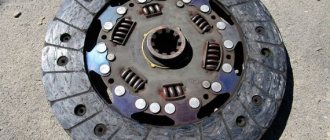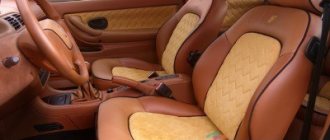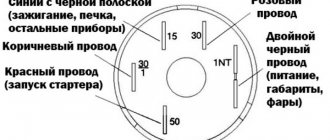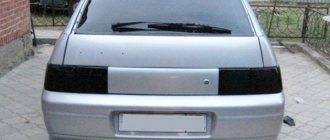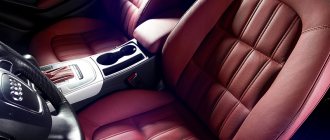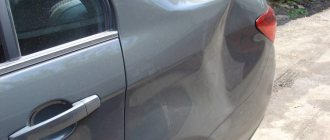- Definition of a drowned car
- Important signs of a car that has been in water
- Other characteristic signs of a drowned car
- What to do if you bought a drowned man?
Choosing a car is a difficult and responsible task, which is sometimes beyond the power of an inexperienced car enthusiast. This is what all kinds of scammers and dishonest sellers, who hang out in large numbers at car markets, prefer to take advantage of. And it’s not even as scary to buy a damaged or repainted car as to inadvertently buy a car that has been in water.
Drowned car
Definition of a drowned car
“Drowned” is a car that has been completely or partially under water, due to which its general condition is very deplorable and dangerous for movement, and it is considered unsafe. Such specimens are not only victims of floods or other disasters, but also those that were flooded during a sewer break, fell through the ice, or cars got stuck in a swamp. The previous owner, of course, wants to get rid of it as soon as possible - driving such a car is unsafe. And since a “drowned car” costs pennies on the market, dishonest car owners prefer to invest some money in repairs and hide all traces of the incident. However, it is still possible to distinguish such a car.
Is it worth buying a “drowned” car?
The new week began with television footage of a huge flood in the UK. There hasn’t been such an abundance of water there for hundreds of years. There are hundreds of cities and villages up to your neck in water. It's not just British homes that are flooded. The roofs of thousands of cars are barely visible in the waves. And this is perhaps the most alarming thing for us. Because, as experience shows, most of the “drowned” cars will soon end up on the markets of Eastern Europe and Russia. Dried, washed and polished to a shine, they will be offered to you and me. But is it worth buying these?
Oddly enough, but purchasing a “drowned man” promises not only problems, but also advantages. Let's try to figure them out.
If earlier, flooded cars were indiscriminately put under pressure, now enterprising owners and insurance companies are not averse to making extra money from car enthusiasts who want to save money. But for the future owner, such a purchase, especially if handled ineptly, can turn into a real headache.
So, you have decided to purchase a “drowned man”. In order not to later exclaim the same thing as the children from Pushkin’s fairy tale (“Daddy, daddy, our nets brought in a dead man!”), you need to approach the selection of a suitable specimen with all responsibility. But in any case, you should prepare for all sorts of surprises that such a car can present.
In the USA, there are many online auctions where you can pick up the desired Pepelats. The largest ones are: copart.com, iaai.com. In America, almost all information regarding a particular car is present in the Carfax database. So you can always find out all the “ins and outs” using the VIN code. Neither the actual mileage, nor the number of owners, nor even the fact of an accident in which the car was involved will escape your attention.
For a number of reasons, it is quite difficult for a private person from Russia to participate in an auction. Therefore, it is better to use the services of intermediary companies. They also organize the delivery of the dried “goods” to their destination.
You can independently select the desired lot and place a purchase order at a given price. As a rule, a detailed description is given on the auction website, including all damage. Sometimes completely new cars go on sale, but, nevertheless, they have been in the dumps. This happens if a car dealer parking lot is in a flood zone.
Among the “drowned”, it is better to choose SUVs, since they have more ground clearance, which means that the water, hopefully, has not reached too high. Although in the case of jeeps, many nuances need to be taken into account. It is best to look for specimens in which the water did not rise above floor level. In any case, before placing an order, you need to thoroughly study the features of the machine you plan to purchase. Peruse the forums, find technical documentation for the car. This will help you find out what equipment is installed in the flood area.
And, of course, find out about the cost of potentially necessary replacement parts. Any car enthusiast knows that the most “surprises”, as a rule, come from electrical equipment. So, the electrical wiring in any car is also laid on the floor. There are also many different electronic control units installed there.
And it’s okay if the car is flooded with fresh water. What if the sea or ocean overflows its shores? Then things will be much worse. Because your enemy in this case will be salt water. And salt is not only an excellent conductor, but it also causes corrosion of electrical contacts. So you need to be prepared - at one point your faithful “horse” may “buck.”
I will give an example from personal experience. My friend bought a brand new, but “flooded” SUV. At first glance, the purchase seemed very profitable. A “stuffed” three-liter Volkswagen Touareg cost only 20 thousand US dollars. Water poured over the rugs.
Initially it was clear that the engine control unit needed to be replaced. But that didn't scare me. Just think, some 50 thousand rubles? But you are the happy owner of a cool “car”. And indeed: after replacing the control unit, everything returned to normal. The car started and drove off.
But some time later, out of the blue, the Touareg suddenly stalled and completely refused to start. Diagnostics at an official dealer showed that there is no pressure in the fuel system. The servicemen could not give a clear answer to the question: “What is the reason?” It was only suggested that the fault be found by replacing parts that came under suspicion one by one. And this already promised exorbitant expenses.
Fortunately, my friend turned out to be more savvy than these masters. And I myself found the cause of the breakdown.
But, unfortunately, not everyone is so lucky. I know of a case where in a Mercedes ML, which found itself in water up to the glove compartment, the piston rings in the engine “acidified” - the water penetrated so deeply inside. I think the cost of restoring such a drowned man is not difficult to imagine.
The only indisputable advantage of such a purchase is customs clearance at more favorable rates. So, if the car is damaged, you can provide an independent assessment of the damage, and the customs value of your car will be reduced by this amount.
Whether to buy or not, everyone decides for themselves. But you need to remember that such a purchase is always a lottery.
Important signs of a car that has been in water
- The first sign by which it is easiest to distinguish a “drowned person” is problems with the electronics.
In such a car, all wires and connections begin to rust and short out, spontaneously turning devices on and off. The on-board computer may freeze and turn off spontaneously from time to time, the lighting may act up, and the power windows, for example, may raise and lower the windows at will. Green plaque and rust appear on the wires themselves and the units connected to them.
The former owner is unlikely to change all the electronics on the car - this is a very decent amount. If a used car has new electrical sensors and devices or there is even the slightest suspicion about the car’s “wet past,” it is better to refuse to buy it, no matter what discounts the seller promises you, and no matter what excuses he comes up with.
- Rust is the second sign of a drowned car.
In addition to the fact that all units rot, water can accumulate in hidden cavities, from which it is practically impossible to pump it out, and where it does its “wet work”. Thanks to this, the car rots everywhere and very quickly, and rust appears in the most unexpected places all at once, and not in small individual spots. In the interior, rust can be hidden under the trim, so this must be checked. All moving parts suffer greatly from contact with water - water quickly washes away the lubricant. Rust is very noticeable on brake discs, so new discs on an old car that is starting to rust should be a concern.
Without lubrication, the car begins to break down on itself - friction between parts and unprotected components can fail the new owner at any moment. It's even worse if water gets into the engine or gearbox, but this can be detected by a characteristic erratic idle. A drowned car can also release dirt and sand, which end up in the most unexpected places.
How to identify a sunken car
When restoring a sunken car, the craftsmen have one task - to give the car the most presentable appearance, so that it can be quickly sold at an attractive price, and the problems that arise with it concern only the buyer. However, there are a number of signs by which you can identify a sunken car at the time of its inspection:
It is the interior that suffers the most when a large amount of moisture gets into the car. It is very difficult to eliminate all the consequences of flooding, and the buyer should especially carefully inspect the joints where there may be “bubbles” or rust. You can lift the upholstery a little and see if there are any signs of corrosion on the metal parts underneath. If the car has retractable parts, you should take them out and use a flashlight to make sure that there is no corrosion in the niches. Cars rarely “rot” from the inside, so when buying a car with low mileage that is less than 15 years old, there should definitely be no rust in the interior;
Salon.- Smell. Getting rid of the external signs of a drowned car is easier than eliminating the smell of rot that remains on wet upholstery even after it has dried. The wooden elements of the interior also begin to rot, which is also characterized by an unpleasant odor. Please note: To hide the smell, sellers purchase strong air fresheners for “recessed” cars. If there is a strong aroma of air fresheners in the car, you need to be wary or even sniff the individual parts. When even the seats smell of chemical air fresheners, salespeople will often say that perfume or something similar was spilled in the car, but such explanations should be trusted with caution;
Rust. The main symptom that sellers try to hide when selling a “drowned car” is traces of rust. However, even if all traces of corrosion are removed at the service, then after a few days or weeks that the car is on sale, new spots of rust will appear. It is necessary to inspect not only the body, but also the engine for corrosion. Particular attention should be paid to aluminum parts. If the car was drowned in salt water, characteristic white spots and a grayish coating will begin to appear on the aluminum. Sellers clean them with solvent, and these areas become too clean. Take a close look at suspiciously clean elements of the car;
- Suspiciously clean “consumables”. Before selling a car, there is no point in changing its oil, brake fluid, filters and other consumables. At the same time, new liquids are poured into the drowned people and, most often, a new filter is installed. These points must be paid attention to during inspection.
- Headlights. Sea water leaves marks on headlight reflectors. If it is not possible to bring them back to normal, sellers often simply replace the lighting fixture with a new one.
If the car seems normal based on the signs listed above, you can also check it in the following ways:
Get into the car and start the engine. Turn on the interior heating at maximum power, while closing the doors and windows. Sit in the car for a couple of minutes, and if the windows and dashboard begin to fog up, this means that the car has been “drowned”. Moisture can also form on the rugs.
- Start the engine and listen to the operation of the bearings. If they hum, it may be caused by the lubricant eroding due to water getting into it. If you have a stethoscope, you can listen to the generator, air conditioner and other units for the presence of such defects.
- Pay attention to the operation of the electronics when the engine is turned on. It is important that when the engine starts, all the lights on the dashboard come on and then go off. If possible, drive a few kilometers. If the wiring was poorly dried or the connectors were not cleaned, when hitting bumps, “crickets” may appear - the indicators on the instrument panel will light up spontaneously.
Important: If you have the slightest suspicion that the car has been restored after drowning, take the car to a service center to specialist electricians who can diagnose the condition of the electronic system.
( 396 votes, average: 4.54 out of 5)
How to properly break in new summer and winter tires
Why do car windows sweat, and what can I do to prevent fogging?
Related Posts
Other characteristic signs of a drowned car
Cars that have been in water for a long time acquire a characteristic unpleasant odor, which is almost impossible to get rid of later. If the interior of the car is so perfumed with all kinds of fresheners that it is impossible to even breathe, it means that the car has been lying at the bottom for more than one hour. Water also negatively affects the seats and dashboard, which cunning owners are trying to replace. Faded headlights with condensation also indicate long-term contact of the car with water. You should carefully inspect all rubber seals; mold and rust may accumulate under them. The main suppliers of drowned cars for our country are Japan and the USA, since various natural disasters regularly occur there. In these countries, such a car practically cannot be purchased, which dishonest exporters happily take advantage of, buying them for pennies. If it is forbidden to hide a car’s past in foreign documents, it is written about it quite prominently, but when arriving in Russia the cars are sold as simply used ones, and for good sums at that.
What to do with the engine?
Basically, flooding a car with water does not happen without liquid getting into the engine. Moisture is extremely dangerous for the engine, so starting it with the understanding that the car has been in water is not recommended. Liquid enters the engine through the oil plug and throttle body. Restoration work on the engine after the car gets into water should be reduced to the following procedures:
- Dismantle the cylinder head.
- Let the parts dry.
- Replace the piston rings.
- Drain the oil from the system.
- Remove and clean the throttle.
- Replace oil and air filters.
After all of the above, it is necessary to test the spark plugs and ignition coils for serviceability. If there are any problems with them, they should also be replaced with new ones.
The video will talk about restoring a sunken car:
Published: February 26, 2020
What to do if you bought a drowned man?
For some reason, dishonest exporters and dealers “forget” to transfer the relevant notes about the car’s past, so you need to carefully study the documents of the manufacturing countries. Forgery of documents is a serious crime, not every dealer would risk getting dirty with it. If the purchase of a “drowned car” nevertheless takes place, and the past of this car comes to light very quickly, then in order to drive it safely, you need to completely disassemble the car down to the smallest parts, dry everything, lubricate it and carry out anti-corrosion treatment. Most of the units will have to be replaced altogether - the price of all this “revival” may even exceed the price of the purchase itself.
Beware of such cars, because your safety is worth much more than the most significant discounts. Good luck on the roads!
